
Hiking Around Las Vegas, Gold Butte National Monument

 Gold Butte Wash Road approaching the old well (view NW) |
Overview Just a dilapidated well site, Gold Butte Wash Well is an historic site that helps tell the story of ranching in the Mojave Desert during a time of changing climate. At the end of the last Ice Age, only some 10,000 years ago, this area was wetter and cooler, and lower-elevation places like Gold Butte Wash supported a Pinyon-Juniper Woodland where American Bison may have roamed. Since the end of the Ice Age, the land has dried out, temperatures have warmed, conifer trees are found only on the mountain tops, and this area now supports only Mojave Desert Scrub vegetation. When shepherds first entered this region in about 1880, they found a vast rangeland of grasses and forbs with water emerging from springs all over the place. Cattle ranchers came soon after and found that the sheep were already eating too much vegetation and that the range was changing -- it was drying out and favored forage species weren't growing back. Link to map. |
 |
Ranchers used force of arms to run the shepherds off the land (the lead-infused bones of some hapless Basque Shepard probably still lie bleaching under the desert sun), but the land continued to dry, the vegetation still wasn't growing back, and the cattle were lean. In response to drying conditions, probably after droughts in the 1920s when oral histories record that a rancher walked from Gold Butte Townsite to St. Thomas stepping entirely on the bloated bodies of dead cows (obviously an exaggeration, but the sentiment remains), ranchers started in earnest drilling wells, improving springs, and damming washes. In the 1930s, ranchers convinced the Federal government to establish a 200-man Civilian Conservation Corps (CCC) camp at Whitney Pocket to work on building check dams in the Virgin Mountains and developing water structures to benefit the ranchers. |
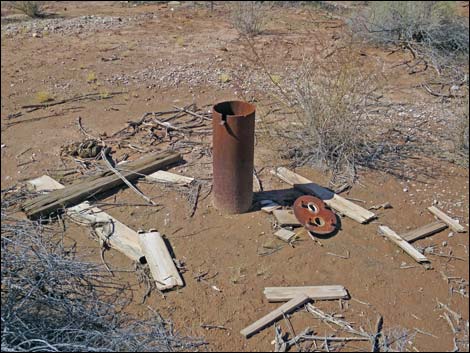 The actual wellhead |
Since then, ranchers remember fondly the memories of their predecessor's vast herds of cattle, but the herds now are small, and the cows are bony. Oral histories record that ranchers could eke out a living, but cattle ranching never was very profitable, and the thing that kept them going financially was to get lucky and sell some nasty bull to the rodeo. In the 1980s, as Las Vegas was starting to boom, the county began working with the Bureau of Land Management (BLM) to acquire more land for development. The lands surrounding Las Vegas are habitat for Desert Tortoise, a species listed as Threatened under the Endangered Species Act, and to take habitat from a protected species, developers are required to "mitigate" its actions. Mitigation can be done in many ways, and one way is to improve degraded habitat elsewhere in exchange for destroying habitat in the construction zone. Clark County decided to take this route and raised tax-payer money to buy-out ranchers in Gold Butte and retire their grazing allotments. By removing cattle from the landscape, more vegetation and water would be available for tortoises, and hopefully tortoises in that area would grow more healthy, reproduce better, and hopefully populate the area with more tortoises. |
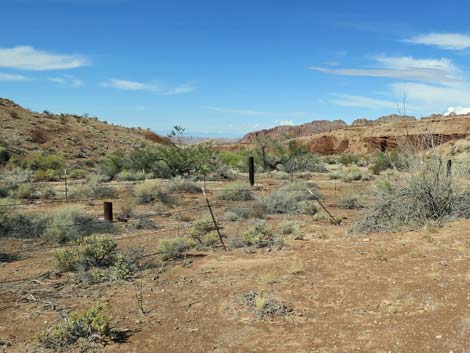 |
In central and southern Gold Butte, Clark County found willing sellers. There were ranchers who had only ever eked out a living and now were offered seemingly "huge" sums of money to retire or move on. While hiking at Falling Man, probably in 2015, I ran into the grown children of one of those ranchers. They had gone to southern California for some family reason, and on the way home, they stopped in Gold Butte to visit the land where they had grown up. While they were nostalgic for the old days, they were thrilled to have been given the opportunity to move on to better things. The family had taken the money, moved to Missouri (if I recall correctly), and bought a farm where you could put seeds in the ground -- and they just grow. They didn't have to worry about water or irrigation, it just rains and the plants grow. They actually spoke of this in excited terms. From their perspective, receiving mitigation funds was the greatest thing that ever happened to the family. |
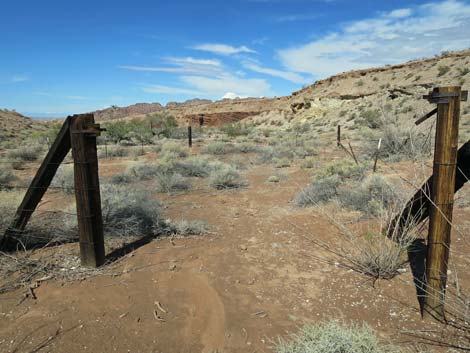 |
As the land continues to warn and dry, the springs continue to dry up and the vegetation remains sparse. In the spring, however, when tortoises are active and breeding, the landscape can be covered with seasonal grasses and forbs, and the tortoises have free reign to wander about and eat all they can. Sure, they share the forage with other wild creatures, but except for a few feral cattle, the wild creatures have it all, and this seems to be a win-win for all involved. While the details of history of this particular well probably are lost, this well site makes for an interesting stop while driving the Gold Butte Backcountry Byway or the Sand Wash-Mud Wash Loop to stop and contemplate this history of white settlers on this changing land, but this isn't a destination. |
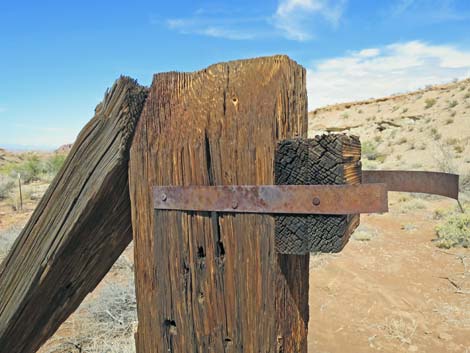 |
Watch Out Other than the standard warnings about driving in the desert, ... this site is pretty safe, but watch for wire that could be a tripping hazard, and watch for rusty nails in boards. This is wild and remote country without services of any kind (no restrooms, no water, no gas, no food). Bring what you need to survive. Be prepared and be self-reliant. Law enforcement occasionally patrols the area. It is a big place, but someone will eventually find you if you stay on a main road, but be prepared to survive alone for a day or two, or even longer on side roads. While out, please respect the land and the other people out there, and try to Leave No Trace of your passage. Also, this is a remote area, so be sure to bring the 10 Essentials. Please be careful with the corral. This is the only one like this most of us will ever get to visit. |
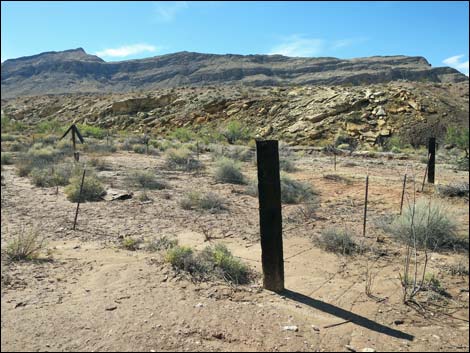 |
Getting to Gold Butte Wash Well Gold Butte Wash Well is located out in Gold Butte National Monument at the northeast end of Lake Mead, about 3 hours northeast of Las Vegas in a wild, remote, and scenic area. From town, drive out to Gold Butte National Monument. From Whitney Pocket, continue south on the unpaved Gold Butte Road for 3.9 miles to Mud Wash North Road on the right. Turn onto Mud Wash North Road and drive southwest 3.2 miles to Mud Wash Road. Stay right onto Mud Wash Road and continue west down the wash for 5.1 miles to the end of the road where Red Bluff Spring Road exits the wash to the left. Drive south on Red Bluff Spring Road for 1.9 miles to Gold Butte Wash Road, on the right. Turn right onto Gold Butte Wash Road and drive back north (down the wash) for 0.3 miles to Gold Butte Wash Well (Table 1, Site 1842), on the left. |
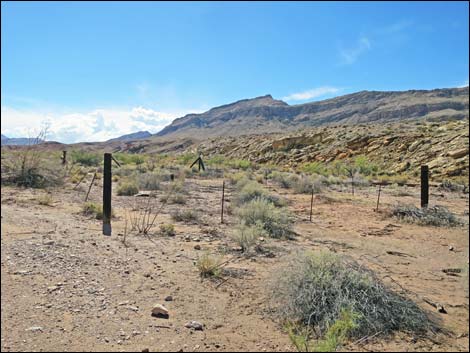 Gold Butte Wash Well Site (view S) |
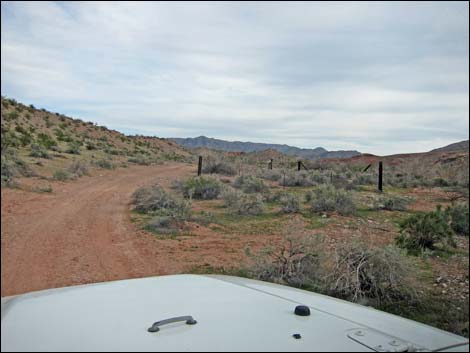 Gold Butte Wash Road at Gold Butte Wash Well Site (view SE) |
Table 1. Highway Coordinates Based on GPS Data (NAD27; UTM Zone 11S). Download Highway GPS Waypoints (*.gpx) file.
| Site | Location | UTM Easting | UTM Northing | Latitude (N) | Longitude (W) | Elevation (ft) |
|---|---|---|---|---|---|---|
| 1842 | Gold Butte Wash Well | 747870 | 4036670 | 36.44508 | 114.23455 | 1,829 |
Happy Hiking! All distances, elevations, and other facts are approximate.
![]() ; Last updated 240325
; Last updated 240325
| Backroads Around Las Vegas | Hiking Around Las Vegas | Glossary | Copyright, Conditions, Disclaimer | Home |